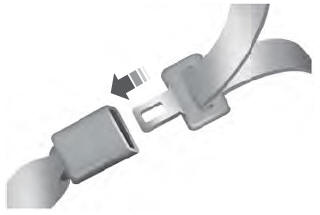Lincoln Aviator: Front End Body Panels / Removal and Installation - Radiator Grille Opening Panel
Removal
NOTE:
Removal steps in this procedure may contain installation details.
-
Remove both the headlamps.
Refer to: Headlamp Assembly (417-01 Exterior Lighting, Removal and Installation).
-
Remove the Horn assembly.
Refer to: Horn (413-06 Horn, Removal and Installation).
-
Pull and remove the radiator air deflector.
-
Remove and position aside the air intake pipe.
-
Remove the bolts and the Air intake venturi.
Torque:
71 lb.in (8 Nm)
-
Remove the bolts.
Torque:
44 lb.in (5 Nm)
-
Disconnect the electrical connector, remove the retainers and the cruise control sensor assembly.
-
If equipped
Disconnect the electrical connector.
-
If equipped
Remove the bolts and the pedestrian alert system assembly.
Torque:
71 lb.in (8 Nm)
-
Disconnect the electrical connector and remove the outside ambient temperature sensor.
-
Disconnect the electrical connector and retainer.
-
Open the hood latch release cable junction block cover.
-
Detach and position the rear hood latch release cables aside.
-
Detach the cable from the mounting bracket.
-
Disconnect the hood latch release cable end and position the rear hood latch cable aside.
-
Detach the hood latch release cable junction block
and position the front hood latch cable and junction block assembly
aside.
-
Disconnect the electrical connector.
-
Disconnect the MAP sensor connector.
-
Remove the bolts and the front bumper.
Torque:
35 lb.ft (48 Nm)
-
Remove the bolts.
Torque:
62 lb.in (7 Nm)
-
Remove the bolts and the radiator grille opening panel.
Torque:
97 lb.in (11 Nm)
Installation
-
To install, reverse the removal procedure.
-
Carry out the Cruise control radar alignment procedure.
Refer to: Cruise Control Radar Alignment (419-03B Cruise Control, General Procedures).
Removal
NOTE:
Removal steps in this procedure may contain installation details.
On both sides.
Index-mark the hood hinge location to aid in hood installation...
Other information:
WARNING: Do not insert the nozzle
of a fuel container or an aftermarket funnel
into the fuel filler neck. This may damage
the fuel system filler neck or its seal and
cause fuel to run onto the ground.
WARNING: Do not try to pry open or
push open the capless fuel system with
foreign objects...
Before starting your vehicle, check the
following:
Make sure all occupants fasten their
seatbelt.
Make sure the headlamps and electrical
accessories are off.
Make sure the parking brake is on.
Put the transmission in park (P).
Note: Do not touch the accelerator pedal...
Categories
The front outboard and rear safety restraints
in the vehicle are combination lap and
shoulder belts.
Insert the belt tongue into the proper
buckle (the buckle closest to the direction
the tongue is coming from) until you hear
a snap and feel it latch. Make sure that
you securely fasten the tongue in the
buckle.

To unfasten, press the release button
and remove the tongue from the buckle.
read more
.jpg)
.jpg)
.jpg)
.jpg)
.jpg)
.jpg)
.jpg)
.jpg)
.jpg)
.jpg)
.jpg)
.jpg)
.jpg)
.jpg)
.jpg)
.jpg)
 Removal and Installation - Hood
Removal and Installation - Hood

